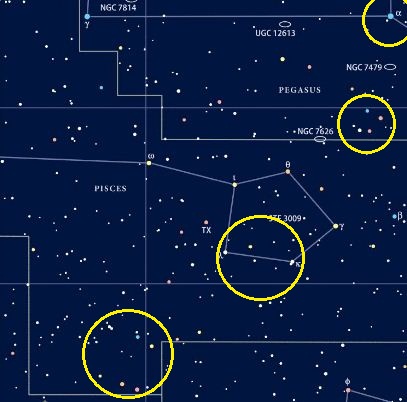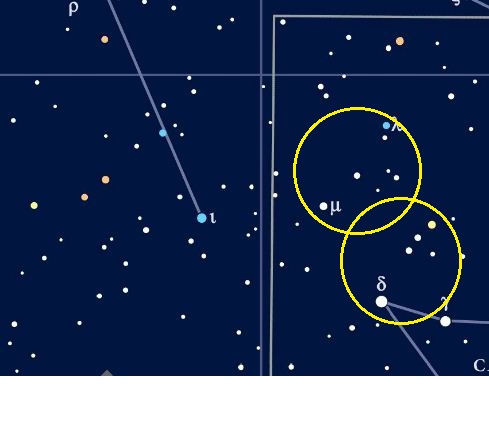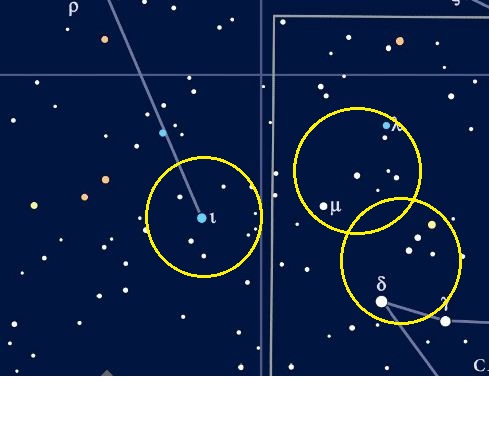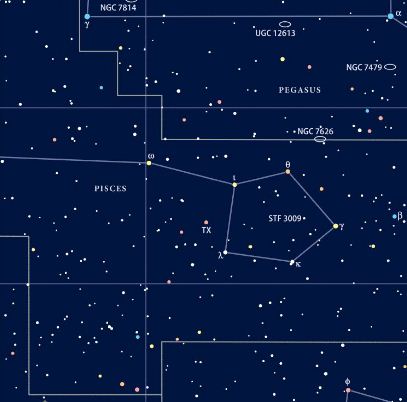Star gazing and planet seeking were not on my Friday night list of must do things. All I really wanted to do was relax after a long stressful work week. And for the most part I accomplished that goal. But I couldn’t resist the siren’s call of the seventh planet. I peeked out the back patio door after nine o’clock and noted the bright nearly quarter moon shining in the southwest. The skies were somewhat clear, not perfect, but better than last weekend by a long shot.
I went back inside and grabbed a folding table, my star charts, the binoculars and a portable battery that includes a bright red light I could set on the table to illuminate my maps. Oh, and my reading glasses so I could actually see said maps.
I took out my observing checklist that I prepared over a week ago for the dark of the moon weekend (the one where the skies remained hidden behind clouds). I had several stars I needed to locate. Using my Pocket Star Atlas and my binoculars, I got in the neighborhood, but the objects were too faint and my night sky not dark enough to find them. I decided to switch from stars to seeking the planet Uranus.
I looked east over the roof of my house. I could see the Great Square of Pegasus, but not a single star visible in the constellation Pisces. I needed to find those stars, or I would not be able to find Uranus. I also needed the stars to move westward a bit more to clear the roof and to get into the thinner atmosphere directly overhead.
I returned to the interior of the house, where Terry and I squeezed seven lemons and added some freshly made raspberry syrup to the blender to make some iced raspberry lemonade. Our initial taste testings resulted in a quite tart concoction, which we shelved it in the refrigerator to tackle again on Saturday.
 I went back outside after ten o’clock and closely reviewed the special chart provided by Sky & Telescope via an article on one of their observing blogs entitled ‘Uranus and Neptune in 2012.’ I made sure to print that PDF (something I rarely do these days) and kept it close by both my binoculars and the telescope. Despite the fact that I could not see a single star in the constellation Pisces with my naked eyes, I forged ahead with my binoculars, star hopping my way to 44 Pisces and Uranus. For a good online article on how to use a star map at the telescope, check out this Sky & Telescope link.
I went back outside after ten o’clock and closely reviewed the special chart provided by Sky & Telescope via an article on one of their observing blogs entitled ‘Uranus and Neptune in 2012.’ I made sure to print that PDF (something I rarely do these days) and kept it close by both my binoculars and the telescope. Despite the fact that I could not see a single star in the constellation Pisces with my naked eyes, I forged ahead with my binoculars, star hopping my way to 44 Pisces and Uranus. For a good online article on how to use a star map at the telescope, check out this Sky & Telescope link.
Here’s a breakdown of the star hop that worked for me:






I followed these landmarks repeatedly with my binoculars. I got very good at this particular highway in the sky. Translating these landmarks, first to the finder scope and ultimately to the telescope’s eyepiece proved much harder. First, the field of view in the finder scope (9×50; 5 degree f.o.v.) appeared wider than my binoculars, which are 7×35.
 According to the XT8’s Instruction Manual, both the finder scope and the view through the eyepiece of the telescope produce an image that is upside down. I guess I should be grateful that the eyepiece field of view is not also reversed, like it is in my ETX-90. My brain doesn’t have any trouble flipping what my retina receives around. I learned that trick years ago as a legal secretary, when I had to stand before my attorney’s desk and keep up with what he was discussing from the sheet of paper he was reading from in front of him. I can also flip things in a mirror with little difficulty. But doing both takes a bit more brain processing power.
According to the XT8’s Instruction Manual, both the finder scope and the view through the eyepiece of the telescope produce an image that is upside down. I guess I should be grateful that the eyepiece field of view is not also reversed, like it is in my ETX-90. My brain doesn’t have any trouble flipping what my retina receives around. I learned that trick years ago as a legal secretary, when I had to stand before my attorney’s desk and keep up with what he was discussing from the sheet of paper he was reading from in front of him. I can also flip things in a mirror with little difficulty. But doing both takes a bit more brain processing power.
When I looked through the finder scope at Alpha Pegasi, I had to keep reminding myself to go in the opposite direction I had with the binoculars. Even though the field of view in the finder scope seemed larger, my brain thought it was smaller (probably because I was only using half my eyesight). I finally got to my destination, 44 Piscium and, drum roll please, Uranus.
∞∞∞
After visiting the seventh planet for a few minutes, I moved on to fishing for the eighth and final planet. With Pluto’s demotion to a dwarf planet, and being a native Kansan, I plan to follow in the footsteps of Clyde Tombaugh and eventually discover Pluto for myself. But for the moment, I needed to fish for Neptune in the constellation Aquarius.





I found the stars near Neptune easily with my binoculars. And the short hops with the finder scope proved easier than finding 44 Pisces and Uranus. But try as I might, I could not discern which faint star might have a twinkleless blue tinge. I couldn’t confirm I found the eighth planet, so I won’t check it off my list. I did feel satisfied that I could at least get to the neighborhood repeatedly, without referring to the star charts as often.
Midnight crept up on me and I marveled at how the time slips away from me when I’m stargazing. I hoped all my practicing would come in handy Saturday night, when I planned to pack everything in the van and make the trip south to Powell Observatory for some serious observing.


